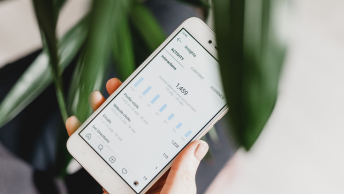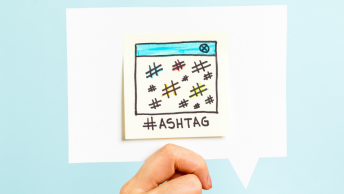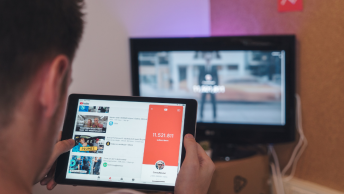Running a successful law practice is about more than winning cases. It takes a strong digital brand to separate your practice from the competition. By leveraging law hashtags on social media, you can define your identity as a lawyer or legal professional, attract more clients, and build a positive reputation. Follow these steps to use law hashtags to promote your legal services.
15 Law Hashtags To Promote Your Law Firm
Defining Your Identity as a Lawyer
Many people seeking representation will encounter your digital brand first. Using hashtags specific to your practice or area of expertise is an effective way to define your digital identity as a lawyer.
Practice-Specific Hashtags
One way to define your digital identity as a lawyer is to present yourself as a knowledgeable source by providing valuable tips to potential clients using hashtags specific to your practice area.
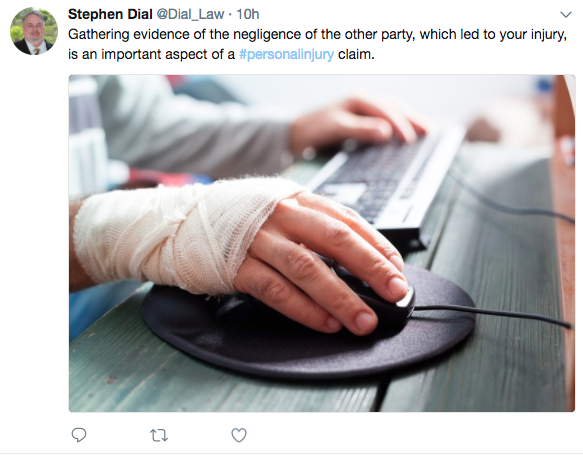
Using law hashtags that are more specific to your firm’s area of expertise is a great way to narrow your targeting efforts to a niche audience.
FindLaw compiled a list of tags for certain types of law practices:
“For more specific tweets about a particular field, such as intellectual property, try searching for hashtags like #IP or #patent. Other popular practice-area hashtags include #personalinjury, #divorce and #bankruptcy“
Another opportunity to showcase your expertise begins with identifying relevant issues and topics.
- What are the current hot button issues of the day in your field?
- How are those issues connected to the services you offer?
- Which of those topics have curated discussions on social media?
Once you have an idea of the topics that are important to your business, you can develop a hashtag strategy and messaging that showcases your area of expertise. This includes:
- Using location-based search features with hashtags to search for potential clients who are looking for services that you offer.
- Finding active Twitter chats that allow you to represent your brand and share your knowledge weekly or monthly.
- Creating a list of every seminar, webinar, meetup or other events related to your specific area of expertise.
The key to defining your brand identity is consistency and repetition. If possible, you should have a set of engagements that you revisit once every week or a few times a month. Each time you consistently use hashtags specific to your practice area, you will increase your exposure and begin to build your authority in your field.
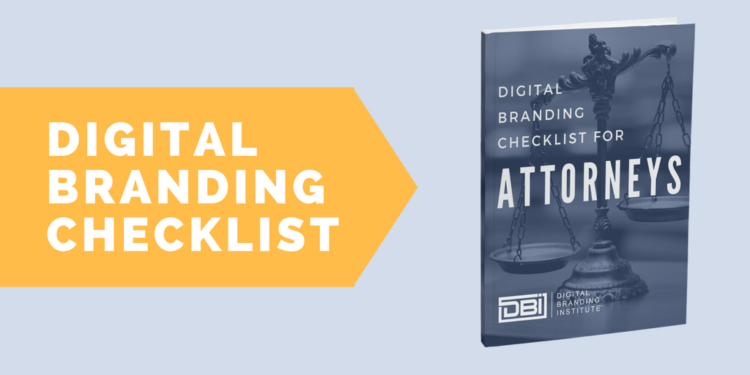
Increase Your Visibility with Hashtags
One of the foremost reasons that people use hashtags is to increase their visibility.
Unfortunately, however, regardless of how much you know about your field or how much experience you have, your ability to increase your visibility begins and ends with the popularity of the law hashtags you use.
Combine popular hashtags with legal hashtags to reach a broader audience.
In the example below, a law office combined the popular hashtag #wednesdaywisdom with a location hashtag and legal hashtags to share their expertise.
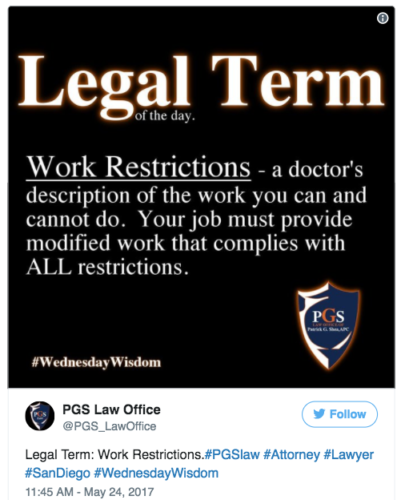
SEE ALSO: The 5 Rules Of Social Media Optimization (SMO)
Build Your Credibility with Hashtags
Of course, one cannot use a hashtag without first reflecting on the effect it will have on their brand. Before you start using law hashtags, map out a plan for the end goal that you wish to have with each hashtag. Research hashtags to make sure they mean what you think they mean and avoid any embarrassing mishaps that can be prevented.
By joining relevant discussions, lawyers and legal professionals can build their credibility and connect with prospective clients.
Use popular hashtags to connect yourself with relevant discussions and simultaneously demonstrate your commitment to professionalism and excellence.
SEE ALSO: 5 Ways To Protect Your Company Reputation on Social Media
Best Practices
A Note On Hashtag-Jacking
In order to discuss best practices when it comes to using hashtags, it is useful to begin by discussing hashtag faux pas.
Hashtag-jacking is one of the most annoying things a business (or anyone, for that matter) can do.
Hashtag-jacking using a hashtag that has nothing with your brand in an effort to co-opt the audience participating in that particular conversation. For example, using #LawandOrder or #FoodNetworkStar to promote your criminal justice firm is in bad form (Although one relevant strategy could be to have your brand or individual team members join the live Twitter feed for tv shows, like Suits, How to Get Away with Murder, Criminal Minds, etc)
Whether the hashtag is similar to your brand or not, trying to use established brands or trending topics for no other purpose than to promote your services comes across a bit desperate and tacky…Neither are words you want to be associated with your business.
So rather than selling, always look for ways to add value to discussions by providing meaningful commentary.
If your strategy is to join the discussion happening on #IDAddicts hashtag (official hashtag of the Investigation Discovery channel), do not do so by making every Tweet an advertisement for your services. Join the conversation by adding relevant and informative contributions.
Tools for Identifying Hashtags
There are quite a few online resources for finding the best hashtags.
RiteTag is at the top of the list.

RiteTag works by finding the most popular Twitter hashtags related to the hashtags you search for.
Results are divided into three categories;
- Very active – Use these to get seen now (green)
- Somewhat active – Use these to get seen over time (blue)
- Not active – These hashtags are not currently active (gray). In other words, there are more valuable ways to use your Twitter character limit real estate.
It is good practice to use a mixture of both very active and somewhat active hashtags. This is because the ones that are very active are often so popular that it’s easy to get lost in a sea of tweets when you use them.
Somewhat active hashtags, on the other hand, have just the right amount of engagement. So you will be seen over time and are less likely to get lost in the noise.
In general, most brands opt to use 1-3 hashtags per post. So you can experiment with any combination of very active and somewhat active hashtags.
Other online resources for finding popular hashtags include:
- Hashtagify.me
- Trendsmap
- Keyhole
- TagDef
- Top Hashtags
General Hashtags For Law
Now that we have gone over a basic overview of what hashtags are and how they are used, we can discuss the most commonly used ones in the legal professionals.
Twitter + Instagram:
- #Law
- #Legal
- #Lawsuit
- #Attorney
- #HarvardLaw
- #Lawyer
- #Lawyers
- #Justice
- #SupremeCourt
Instagram Only:
- #Lawyerlife
- #Justice4All
- #Lawsuit
- #LawFirm
- #InstaLawyer
- #Legally
- #CriminalDefense
- #InnocentUntilProvenGuilty
- #Felony
- #Misdemeanor
When possible, use a combination of these to boost engagement on your posts.
Hashtags for Recruiting
Law hashtags can also be used to attract talent and recruit lawyers for your practice. While hashtags should not be depended upon as your main source of exposure, hashtags related to law school and law students can also be a secondary source of exposure for your firm to reach potential hires. Here are a few to start with:
- #LawStudentProblems
- #LawStudentLife
- #LawStudents
- #LawSchoolBound
- #LawSchoolGrad
- #LawSchoolLife
- #LawSchoolProblems
- #LawSchoolLife
- #LawSchoolProbs
Conclusion
Law hashtags should be an essential part of your firm’s social media marketing strategy. When used properly, hashtags can be a tool to generate new leads, solidify your position among competitors, and enhance your reputation.
Does your firm currently have a strategy for using hashtags on social platforms? What are some of your favorite hashtags to increase exposure?




